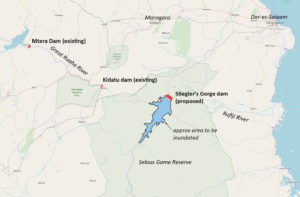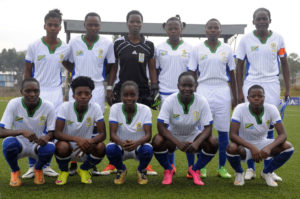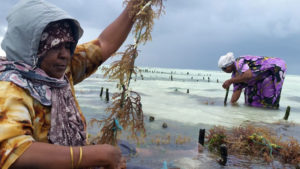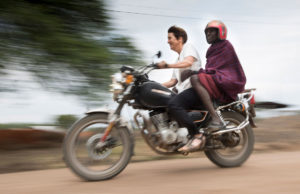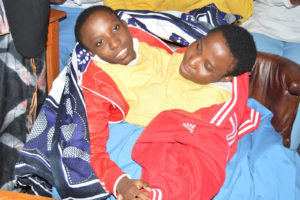by Martin Walsh
IN AND OUT OF THE MAASAI STEPPE. Joy Stephens. BestRed, Cape
Town, 2016. x + 266 pp. (paperback). ISBN 978-1-928246-12-1. £24.50.
I was swept back to my days working in villages in Tanzania by Joy Stephens’ beautiful book about the Maasai, a Nilotic ethnic group, famously colourful, living in northern and central Tanzania. At various times I had the chance to talk to Maasai and found their perspectives refreshingly direct and their sense of humour engaging.
Stephens spent much time over a period of 14 years first setting up, and then visiting Maasai women’s groups, and latterly the women’s families. She helped the women use their traditional skills of beading to earn income for their families, and in this way got to know them. She writes passionately about their wisdom, their deep knowledge of their homeland and the skills they possess to thrive in a hostile environment.
The setting up of the women’s groups is described, and through this we become acquainted with several characters who appear throughout the book. She follows the development of the groups, recording the pitfalls, the unexpected outcomes, the frustrations and successes, with respect and humour but never patronising, understanding that with their very different outlooks, there will inevitably be difficulties as the women tackle the puzzles of modern capitalism. As well as this, interwoven in the text, she provides us with accounts of the history of the Maasai in Tanzania, through colonial times until now, their survival of repeated assaults on their way of life, and how colonialism negatively affected the role of women in Maasai society. There is a brief history of beadwork, and a description of the heart-breaking effects of the long drought of 2006.
Stephens finishes by wondering whether the Maasai will survive the tremendous changes and pressures that are encroaching upon their unique lifestyle, whether they can adapt, and worries that even people like her, trying to promote women’s rights, are part of the onslaught. It is a thoughtful, uplifting book full of insights, and made me want to return to Tanzania and spend more time with Maasai people before it is too late.
Kate Forrester Kibuga
Kate Forrester Kibuga lived in Tanzania for 15 years, working as a freelance consultant chiefly in social development. She carried out research assignments throughout the country and encountered Maasai on many occasions. She now lives in Dorchester, where she is active in community and environmental work.
SHIPWRECKS AND SALVAGE ON THE EAST AFRICAN COAST (Second edition). Kevin Patience. Short Run Press, Exeter, 2018. 300 pp. (hardback). ISBN 978-1-5272-1430-9. £15 (UK price including postage and packing, available from the author at saburi@hotmail.com)
This book – an updated second edition from the initial 2006 publication – offers a fascinating catalogue of shipwrecks, strandings and salvages along the East African coastline and interior Great Lakes. The ships in question are almost entirely major Western-constructed vessels, with no attention given to Arab, Indian or local Swahili craft. Excepting a brief survey of early modern Portuguese shipwrecks, most are British, German or Scandinavian commercial sea craft built in the 19th and 20th centuries.
The author, who has produced several shorter East African maritime histories, is himself a former salvage diver who worked in East Africa and the Persian Gulf since the 1970s. This expertise informs the author’s confident explanations of how each vessel came to be wrecked, damaged or stranded, and in particular what operations were necessary to repair, salvage or scuttle each recoverable ship. This makes for surprisingly interesting reading. Nearly every ship entry includes vital data on its construction and casualty location, a picture of the vessel, and a long paragraph – sometimes several paragraphs for the more interesting cases – that explains the ship’s history, service, damage, and ultimate fate. This includes 32 shipwrecks and 69 strandings and salvages off the Kenyan coast; 44 shipwrecks and 41 strandings and salvages off the Tanzanian coast; and 18 total cases in the Great Lakes. Organised alphabetically by vessel name, the book is best read as an encyclopaedia to be dipped into, although a few major themes do emerge across the entire book.
First, the two events that produced the most shipwrecks in East Africa were the Zanzibar hurricane of 1872, in which over 150 vessels were lost, and the maritime military engagements of the First World War. The latter provides the most dramatic material of the book. Much the best known of these historical shipwrecks is the SMS Königsberg, the German cruiser which, after leading one of the most dramatic naval hide-and-seek missions of the First World War, was scuttled in the Rufiji Delta in July 1915 after British bombardment, becoming an odd tourist destination before finally disappearing into the Rufiji riverbed in 1966. Even more curious are the First World War’s maritime casualties on Lakes Tanganyika and Victoria – Lake Nyasa (Malawi), puzzlingly, is not covered in the book. In all cases, the material legacies of these conflicts shape the maritime aftermath of this region – from Dar es Salaam’s long-congested colonial harbour to the repurposed commercial vessels of the Great Lakes.
Second, more recent wrecks have come at greater expense of human life. The most famous of these by far is the MV Bukoba, which sank in Lake Victoria in 1996 costing 869 lives. Other commercial ferries, often ill-suited for heavy commercial work, have produced similarly grisly results – the Kilindi-Mombasa ferry MV Mtongwe, which sank in 1994 leaving some 276 dead, and more recently the oceanic tragedies of the MV Spice Islander (2011) plying between Unguja and Pemba, and the MV Skagit (2012), plying between Zanzibar Town and Dar es Salaam, which left over 200 and 146 dead, respectively. The catalogue-entry nature of this book prevents any developed analysis of these trends, but it is fairly easy to discern the deadly combination of older, ill-maintained craft and inadequate regulation in these tragedies.
Finally, this book is effective in showing the more quotidian ways in which most ships come to be wrecked, stranded, and salvaged. Most ships in East Africa came into trouble not through violent weather or warfare, but rather through bungled steering, poor ship-to-shore communication, engine failure, fire, and internal explosions. Their repairs and salvages were unsentimental business decisions, though their remains survive as local landmarks and sites of underwater pilgrimages for intrepid divers. To behold the long line of container ships idling on the waters near Dar es Salaam has become a regular sight over the past decade, a reminder of the region’s rapidly growing global commerce and struggling infrastructure, and the irreplaceable role played by transoceanic commercial shipping. For those with more than a passing interest in history of commercial and military ships in the region, this book is a rewarding resource.
James R. Brennan
James R. Brennan is Associate Professor of History at the University of Illinois, and is author of the book Taifa: Making Nation and Race in Urban Tanzania (Ohio University Press, 2012).
THE ROMAN EMPIRE AND THE INDIAN OCEAN: THE ANCIENT WORLD ECONOMY AND THE KINGDOMS OF AFRICA, ARABIA AND INDIA. Raoul McLaughlin. Pen & Sword Maritime, Barnsley and Havertown, PA, 2014 (reprinted 2018). xix + 276 pp. (paperback). ISBN 9781-52673-807-3. £14.99.
How might a book with the title The Roman Empire and the Indian Ocean be relevant to the 21st Century? Roaul McLaughlin, a classicist from Northern Ireland, barely studies this question directly until the very final pages of his book but then again, he hardly needs to because in reading about Rome’s trade with Africa, Asia and the Far East, the parallels with our supposedly modern world spring out from every page.
Described as “a wonderful book” by the Black and Asian Studies Association, McLaughlin makes a persuasive case that the Roman empire’s trading interactions, whilst they built upon already extensive contacts between Egyptian, Greek and Hebrew traders and their counterparts in Africa and Asia, were on a sufficiently greater scale as to create the world’s first wave of globalisation.
Rome’s seizure of Egypt opened up the empire’s route to Africa and Asia via the Red Sea. A Roman attempt to conquer what is now Yemen failed, but Roman navies controlled the Red Sea from their base in the Farasan islands, opposite what is now Eritrea. By the middle of the first century A.D. fleets of Roman ships were moving to and fro across the Indian Ocean using the seasonal monsoon winds. It is likely that some 120 ships made these annual voyages, some of them with 500 tons cargo capacity – the container vessels of their day. These ships traded as far south in Africa as what is now Tanzania; around the coasts of Arabia and across the Indian Ocean to the kingdoms of what are now Pakistan, India and Sri Lanka. By the middle of the second century A.D. Roman ships were trading in the Ganges Delta of what is now Bangladesh and even around to the tip of the Malay peninsula. Merchant citizens of the empire – Italians, Greeks, Egyptians, Jews – lived and worked in probably all the great ports of India and Sri Lanka. Products from inner Africa which were exported either via the coast or along the Nile included leopard and lion cubs, elephants and ivory, exotic animals and hides, tortoise and turtle shell. Roman ships sailing down the east coast of Africa – Azania – stopped at several trading stations, a large island called Menuthias which was probably Pemba or Unguja (Zanzibar) and finally a port called Rhapta about 100 miles further south. It took vessels at least 60 days to reach this location which was nearly 3,000 miles from the Empire and which marked the limit of Roman trading voyages. Roman records say that Rhapta was managed by Arab traders and exported great quantities of ivory and turtle shell.
McLaughlin presents a huge amount of evidence that the wealth of the Roman empire was based on this trade. Import taxes on eastern goods provided as much as one-third of the empire’s wealth, and he argues that this was what paid for the Roman war effort, with the legions at their peak estimated to number 300,000 soldiers. In fact, it is humbling to read that Gaul, Britain and other provinces of the empire in northern Europe, about which we read so much in history books, were pretty much a drain on the empire’s finances throughout the period. In contrast, the empire obtained astonishing amounts of income and goods from Indian Ocean trade. Every year the empire imported 16,000 tons of pepper and cotton, 10,000 tons of spices, 360 tons of turtle shells and 560 tons of ivory (over 14,000 tusks). Rome became the first and pre-eminent consumerist society. Incense from Arabia perfumed Roman homes and temples, pearls from Sri Lanka and gem stones from India glittered on every wealthy citizen’s tiaras, rings, robes and even sandals (the original diamonds on the soles of their shoes). (Silk was another important commodity but this mainly came overland, and McLaughlin has examined this trade in another book, The Roman Empire and the Silk Routes).
The Roman empire had less in the way of products that the kingdoms of Arabia and Asia wanted, although there were considerable exports of such things as glass and wine. However, Rome did have minerals in fabulous amounts, especially silver, which came from mines in Spain, the Balkans and Egypt. Every year Roman merchant vessels exported vast amounts of bullion and coinage (which was minted with a guaranteed high silver content) to pay for eastern imports.
The other great empire of the day was the Han empire in China which was also at its peak at the same time. These two great powers knew of each other, although only at second hand. The Parthian empire stood between them and jealously guarded its position as middle-man on the silk roads. But in 165 A.D. Rome made direct contact with the Chinese empire by sending a delegation via what is now Vietnam. Trade was undoubtedly a major motive. An alliance to squeeze the Parthians between the two empires may also have played a part. And worries about the military capability of the mysterious Chinese had also begun to concern the Romans; Juvenal in his satires describes Roman women ambushing generals at fashionable dinner parties and demanding to know “what are the intentions of the Chinese?”.
This represents one of the great “what if?” moments of history; what if the Roman and Chinese empires had formed a direct trading relationship and even a political and military alliance?
We shall never know, because it went horribly wrong for both empires at the very moment of meeting. Global trade and contacts brought many benefits; it also spread one of the world’s most devastating pandemics, known in the West as the Antonine Plague. Whatever this disease was – possibly smallpox, possibly measles, possibly an unknown virus – it originated somewhere in East Asia and first spread north through Indo-China to devastate the Han empire. Chinese sources recorded how three in every 10 soldiers died and more were permanently incapacitated. The Romans, meantime, had moved against Parthia and had conquered what is now Iraq when suddenly their troops began to die in great numbers. The legions were recalled to Europe, and brought the plague with them. German peoples took advantage of the chaos and moved across the northern frontiers and the Roman empire began its long and agonised decline.
In a globalised world, all economies were in contact. The plague and chaos killed the miners who produced the silver and gold which Rome used to buy imports. Over the coming decades Roman currency was progressively debased until it was almost worthless. The decline of the mines, debasement of the currency, the death toll among merchants and mariners and decline in consumer demand dried up the trade with Asia. In turn, the regimes and dynasties with which Rome had established long-term relations in China, India, Persia and elsewhere, also began to collapse. McLaughlin describes how “by the second century A.D. the main regimes of the ancient world were so economically interdependent that the fate of one major economy was capable of providing the trigger for world-wide financial collapse and decline”.
At the very end of his book McLaughlin concludes that whilst international trade brought wealth and prosperity, “the forces that destabilised the ancient world economy are still in effect, including the reliance on finite resources for trade wealth and essential revenues. Mass population movements, natural disasters, wars and the threat of global pandemics still have the potential to diminish human progress. Ultimately, this is the significance of distant trade and the ancient world economy”.
John Magrath
John Magrath is a writer and researcher who has worked for Oxfam for over 30 years. In 1994 he worked in refugee camps in the Ngara District in northwest Tanzania. He has a particular interest in climate change and its impacts and implications, especially in East Africa.
A FIELD GUIDE TO EAST AFRICAN REPTILES (2nd edition). Stephen Spawls, Kim Howell, Harold Hinkel and Michele Menegon. Bloomsbury Wildlife, London and New York, 2018. 624 pp. (paperback). ISBN 978-1-47293561-8. £35.00.
This is the fully revised and updated edition of the comprehensive field guide that was originally published by Academic Press in 2002 as a hardback with a slightly different title and line-up of authors (Stephen Spawls, Kim Howell, Robert Drewes and James Ashe, A Field Guide to the Reptiles of East Africa).
As the new Introduction explains: “Since that date there have been many changes in the East African herpetological field. New species have been found in East Africa and described. Existing species have been split, animals have been recorded in East Africa for the first time, range extensions for existing species have been recorded. As a result of systematic studies, particularly those based on DNA and other biological molecules, many species have been reclassified, regrouped and their scientific names changed; new relationships have been discovered.”
Like the first edition, this is an excellent guide: the update includes more than 500 species and is illustrated with 600 new photographs. Those of us who struggled with the incomplete guides that were available before Spawls et al. got to work, will be forever grateful. As a regular visitor to Zanzibar, my main gripe is that the islands are so small on the distribution maps that it’s often difficult to see whether particular species are present there or not – a bolder colour and/or arrows indicating presence would help. In some cases, the colour has been mistakenly omitted on these maps. The Flap-necked chameleon (Chamaeleo dilepis), for example, is shown as absent from the archipelago, whereas it is present on both large islands.
I also wish that lists of local names were included, as they are in some other field guides, like Roberts’ Birds of South Africa, and Henk Beentje’s Kenya Trees, Shrubs and Lianas. Something to consider, maybe, for future editions.
Martin Walsh
Martin Walsh is the Book Reviews Editor of Tanzanian Affairs.

